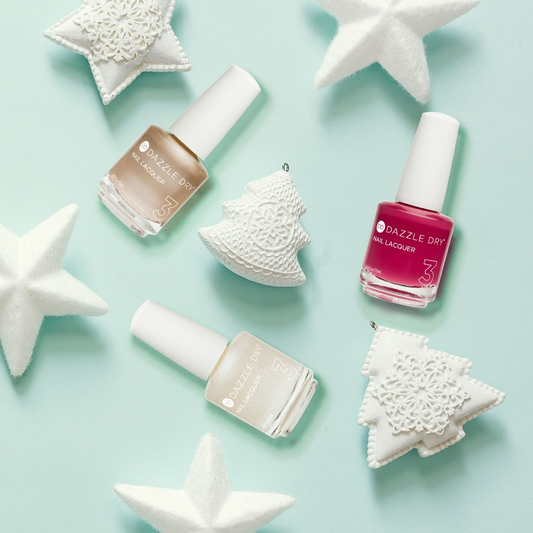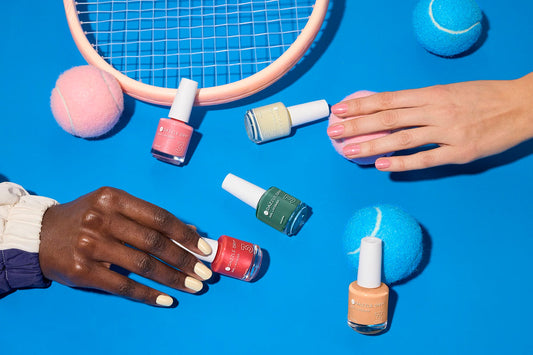Misconceptions and Misleading Deceptions in Nail Care


Misleading or Deceiving? Navigating the Natural Nail Claim Game
With the nail care space being highly competitive, some brands may use tricky means by misinformation, withholding facts, or using strategically misleading words to gain attention and trust. In all fairness, many words aren't actively deceptive on their own but may act as a smoke screen to distract from unsaid facts.
Deception starts when savvy marketers attach words that subconsciously or subliminally connote high-quality attributes without qualifying the perception in proof of performance or formulation. We also know that customers look for online 'buzz' words in searching for products. I'll explore five buzzwords that have become marketing jargon and how they are often used to mislead or deceive.
1) Nontoxic
This word took hold in the nail industry when the Environmental Working Group (EWG) sued nail polish brands for using toluene in their products. The defendants and plaintiffs settled by allowing the use of toluene with a 50% maximum on its concentration in nail polishes. Other polish ingredients such as formaldehyde and dibutyl phthalate followed.
Nontoxic means "will not harm" the user. The word used alone is misleading because toxicity depends on the dose. Even water, essential for life, can be toxic; we can drown and die if we have too much of it. Nail polishes are toxic when ingested but may be nontoxic when used correctly in their intended application.
Formaldehyde, sometimes called methanal or methyl aldehyde, occurs in various forms. As a gas, it can irritate the skin, eyes, nose, and throat and is a known human carcinogen. High levels of exposure could be fatal. As a polymer, formaldehyde is a liquid called paraformaldehyde, formalin, or formol used to preserve biological specimens and is toxic when ingested. In water, formaldehyde forms a diol called methylene glycol. Formaldehyde in its various forms is ubiquitous around us, having found its way (before knowing its harmful health effects) in construction materials, textiles, furniture, adhesives, and cosmetics. The chemicals Quaternium-15, DMDM hydantoin, imidazolidinyl urea, diazolidinyl urea, polyoxymethylene urea, sodium hydroxymethyl glycinate, Bromopol, and glyoxal on cosmetics labels, are preservatives effective in killing bacteria. When heated, products containing formalin and methylene glycol for smoothing hair release formaldehyde gas. With these various terms used in cosmetics, the absence of "formaldehyde" on product labels does not mean that formaldehyde exposure does not occur.
Dibutyl phthalate, also known as DBP, is used as a plasticizer in traditional nail polishes. Most nail polish brands now avoid DBP use because of its listing on California Proposition 65 as a chemical that may have reproductive toxicity, even though no studies are available on its reproductive, developmental, or carcinogenic effects in humans.
2) XXX-Free
In response to the public's call for healthier products, some brands reformulated by removing toluene, formaldehyde, and DBP from their products, marketing them as 3-Free to attract customers. Others recognized this as a marketing masterstroke and called their products 4-free by replacing another inconsequential ingredient. Soon others called their products 5-Free. Others followed with 6-Free, 8-Free, 9-Free, 10-Free, 11-Free, 15-Free, etc., in a frivolous marketing game because a brand may call its product 5678-Free just by listing ingredients that were never in nail polish. While theoretically truthful, this practice is deceptive. Some brands reluctantly use this term as an easy way to answer a potential customer's query.
3) Organic
People recognize and gravitate to this term because the US Department of Agriculture (USDA) defines it as an agricultural product grown and processed without synthetic chemicals. Organic, when based upon this definition, doesn't presently exist in the nail polish arena. However, when used as a term in chemistry, organic refers to naturally occurring and synthetic compounds which contain carbon and other elements such as hydrogen, oxygen, halogens, phosphorus, silicon, and sulfur. Brands using the term in this capacity are not lying… BUT to use the same word in "marketing" without explaining its meaning is deceptive. Before accepting the message as gospel, customers should ask how and why the brand claims its products are organic. Sometimes it is not the brand but its ardent supporters who use this term without the brand's knowledge or approval.
4) Natural
Marketing companies use this term in describing a product because consumers perceive a product made from natural ingredients is better for them. The US Food and Drug Administration (FDA) has not defined the term 'natural' when describing a cosmetic product, and customers have no accepted definition. Webster's dictionary provides "from nature" as a definition of natural. While this is clear to some, an inquiring mind is correct to conclude that all is natural, including synthetic chemicals. Chemists use existing elements and naturally available substances as raw materials to create new ones. Therefore, synthetic chemicals are "natural" because they come "from nature." Therefore, simply using "natural" to describe a nail polish is misleading. The term "natural nail polish" means a polish for natural nails. Furthermore, a thoroughly tested pure synthetic substance could be more effective and safer than a plant extract promoted as natural without a similarly extensive evaluation.
5) Chemical-Free
Webster's dictionary provides two definitions: a) chemical: adjective and b) chemical: noun. As an adjective, a chemical is "of or relating to chemistry," which is not helpful if one is unfamiliar with chemistry. As a noun, a chemical is "a substance made by a chemical process," which means combining elements or compounds to form substances having structures and properties different from the starting raw materials. This process may take place naturally or with human intervention. Therefore, we should consider compounds produced by any biochemical or synthetic method and everything around us as chemicals. To avoid confusion, be more specific by modifying chemicals with adjectives such as synthetic, toxic, reactive, harsh, allergenic, pervasive, harmful, etc.
A synthetic chemical could be more active and healthier when it is pure (containing no contaminants) and well-characterized than a natural extract composed of unknown substances (which also are chemicals). When chemists synthesize a chemical, they know the purity of their raw materials and the resulting product. Their process is well-controlled for yield and product purity to viable commercialization. Essential oils are examples of complex mixtures produced by steam distillation, solvent extraction, or supercritical carbon dioxide extraction. Consumers may consider them better and healthier than synthetic fragrances, yet people also develop allergies to essential oils. At VB Cosmetics, we analyze each lot of essential oil and fragrance oil for toluene and phthalates and reject lots that fail our test. Just because an essential oil, such as rose oil, carries a high price does not mean it does not contain toluene or phthalates.
6) Quick-drying polish, No dry time, Dries in one minute, and Dries in five minutes
These are typical marketing claims for nail polishes nowadays to catch consumers' attention. How dry is it? Can you resume your daily activities after one or five minutes without marring the polish? Is the surface sufficiently dry to prevent smudges or nicks? Can you press a cotton ball to the polish after one minute, and the cotton will not stick or leave marks on the polish surface? Dazzle Dry is the only nail polish system that air dries all layers hard in five minutes to meet these exacting standards. But unfortunately, many brands exaggerate dry times without meeting these or any other defined qualifications. A traditional polish system takes over 60 minutes to achieve the exact dryness level that Dazzle Dry achieves in five minutes. You can be confident that just five minutes after applying the Dazzle Dry system as directed, you may immediately go about your day confidently. Or, if you do your nails before going to bed, they will not show sheet marks in the morning. On another front, any gel polish claiming 'no dry time' should be claiming 'cures with light' as many consumers do not know the difference between the drying and curing processes.
7) Cures with LED, not UV
The original nail lamps to cure the UV Top Coat (which I invented), gels, and gel polishes utilized CFL (Compact Fluorescent Light) bulbs. In 2009, Nail Harmony launched the first gel polish (Gelish®) cured with LED (Light Emitting Diode) as people started questioning the CFL and the UV-A light it emits on human health and the environment. The CFL and LED lamps differ from each other in the manner they produce light. LED lamps are more energy-efficient than CFL lamps. They both emit light in the UV-A region of the electromagnetic spectrum. The CFL nail lamps emit a broader band from 340-395 nm, peaking at 365 nm, whereas the LED nail lamps emit a narrower band from 395-405 nm. Note that UV light spans the range of wavelengths between 10 and 400 nm, with UV-A considered that band between 315 and 400 nm. The region from 400 to 800 nm is regarded as the visible light range. UV-A is carcinogenic, although recently, the FDA ruled that the nail lamps for curing UV gels, when used according to the manufacturers' instructions, pose a low, not no, risk. Instead of misleading by claiming no risk, is it not better to educate the public and let everyone decide for themselves if the risk is worth it?
What can we do about it?
Overall, professionals and customers must question the terms brands use to categorize or market their products. Clever use of ambiguous, overly broad, or overused words may lead customers to invalid interpretations and assumptions. A wrong nail service category may easily direct customers to an inappropriate nail salon or service provider. Customers want services and products aptly targeted to meet their individual needs.
It's time to practice transparency in advertising services and products. Educating clients about your services will result in loyal, happy, and more savvy customers. We also need to stop using "buzzwords" in marketing if we are to elevate the industry at large continually. How and where we create products is also essential, as is assuring superior quality control and purity. Dazzle Dry is proud to formulate from scratch and manufacture in small batches within our state-of-the-art USA facilities.
For nail services professionals, always research the quality and integrity of the brand you believe in because your business depends upon it. Cherish brands that support you and your business, ones that are transparent, knowledgeable, and timely in responsiveness to your concerns.





